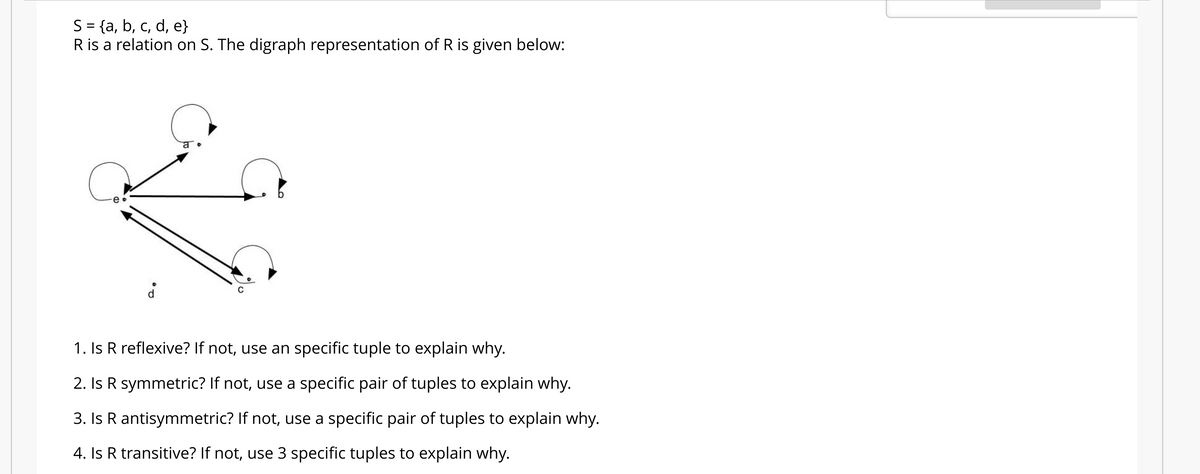S = {a, b, c, d, e} Ris a relation on S. The digraph representation of R is given below: 1. Is R reflexive? If not, use an specific tuple to explain why. 2. Is R symmetric? If not, use a specific pair of tuples to explain why. 3. Is R antisymmetric? If not, use a specific pair of tuples to explain why. 4. Is R transitive? If not, use 3 specific tuples to explain why.
S = {a, b, c, d, e} Ris a relation on S. The digraph representation of R is given below: 1. Is R reflexive? If not, use an specific tuple to explain why. 2. Is R symmetric? If not, use a specific pair of tuples to explain why. 3. Is R antisymmetric? If not, use a specific pair of tuples to explain why. 4. Is R transitive? If not, use 3 specific tuples to explain why.
Elementary Geometry For College Students, 7e
7th Edition
ISBN:9781337614085
Author:Alexander, Daniel C.; Koeberlein, Geralyn M.
Publisher:Alexander, Daniel C.; Koeberlein, Geralyn M.
Chapter1: Line And Angle Relationships
Section1.4: Relationships: Perpendicular Lines
Problem 17E: Does the relation is a brother of have a reflexive property consider one male? A symmetric property...
Related questions
Question
3

Transcribed Image Text:S = {a, b, c, d, e}
R is a relation on S. The digraph representation of R is given below:
%3D
1. Is R reflexive? If not, use an specific tuple to explain why.
2. Is R symmetric? If not, use a specific pair of tuples to explain why.
3. Is R antisymmetric? If not, use a specific pair of tuples to explain why.
4. Is R transitive? If not, use 3 specific tuples to explain why.
Expert Solution
This question has been solved!
Explore an expertly crafted, step-by-step solution for a thorough understanding of key concepts.
Step by step
Solved in 2 steps with 2 images

Recommended textbooks for you

Elementary Geometry For College Students, 7e
Geometry
ISBN:
9781337614085
Author:
Alexander, Daniel C.; Koeberlein, Geralyn M.
Publisher:
Cengage,

Elements Of Modern Algebra
Algebra
ISBN:
9781285463230
Author:
Gilbert, Linda, Jimmie
Publisher:
Cengage Learning,

Elementary Geometry For College Students, 7e
Geometry
ISBN:
9781337614085
Author:
Alexander, Daniel C.; Koeberlein, Geralyn M.
Publisher:
Cengage,

Elements Of Modern Algebra
Algebra
ISBN:
9781285463230
Author:
Gilbert, Linda, Jimmie
Publisher:
Cengage Learning,